Riding The Details
Riding The Details
Sometimes during lessons, when I feel that I have to “tune” the rider’s sensitivity. I place one finger on the medial side of the horse’s brachiocephalic, above its attachment on the humerus and scapula, to make the horse shift his center of gravity backward. The horse does that just before moving back the corresponding front leg. The shift is very brief; it last one third, maybe half of a second. I stimulate the reflex several times until the rider feels the backward shift. I ask then to the rider to initiate forward movement explaining that the horse will likely shift the center of gravity forward over the forelegs before moving the front limbs forward. I warn the rider that the forward shift will be as brief if not even briefer than the backward shift. Through facial expression or body language, I can see the rider’s skepticism, “There is no way that I will feel the shift.” The guilt created by the primitive equitation of the correct aids has convinced almost every rider that they don’t have the capacity of such perception. The horse does not respond to the “correct aids,” as expected in the book, and the book destroys the rider’s confidence instead of rewriting each page in the light of actual knowledge.
At first, the rider does not feel the forward shift. I stop the horse, recreate the backshift, and the rider ask forward motion again until the rider feels the forward shift. The problem is not the rider’s level of perception. The subtlety of the perception is there, but the tensegrity is not. There is a tone of our whole physique that refines our perception. By contrast, passivity, slackness, lack of tone, numbs our sensitivity. Without proper tensegrity, our feeling is limited to gross perceptions. At the other end of the spectrum, contraction numbs our perception as well. Tensegrity is both physical and mental. There is a level of concentration associated with muscle tone.
The usual feedback correction is too slow. The time our nervous system registers the move and process the feeling, the horse is already two steps away. We have to tune our body and our mind into a stage of tensegrity that permits us to filter the forward shift. In his book “Physical Intelligence,” Scott Grafton explains that the brain is capable of concentrates our perception beyond usual capacities. Under proper tone, the rider cans feel the forward shift of the center of gravity as soon as it starts. At this point, the horse has not yet moved the front limb, and the forward shift of the center of gravity can be controlled through a slight adjustment of the rider’s tone. Filtering the horse’s forward shift is not doable, starting with a passive holding of the vertebral column. Relaxation engenders numbness. The time to go from slackness to appropriated tone is too slow. Filtering the forward shift is doable if the horse and the ride’s tensegrity match. From harmonic tensegrity, a slight increase is enough to filter the forward shift of the horse’s center of gravity.
After a few tentative, the rider became capable of filtering the forward shift of the horse’s body, and the horse starts to walk one step at the time in lightness. The horse is always the first to figure such control giving confidence to the rider. The equitation of gestures convinces riders that this level of perception is beyond their reach. The horse is comfortable at this level of subtlety but cannot find it by himself. The rider has to create the conditions and guide the horse mental processing riding the details.
The first step is executed very slowly, and I ask the rider to control the second and third steps though the same subtle nuances of the back and abdominal muscles. Indeed, it would be more accurate to describe the rider’s work as subtle nuances in the tone of the entire physique. There is no management of forces through the horseback muscles without the hind legs’ creating forces. Nuances in muscle tone include subtle nuances in the contact of the rider’s calves with the horse’s body. Often, after several steps, the rider stops, one because the concentration is very high, two because the rider’s mind remains stocked in the equitation of the correct aids. The horse demonstrates that when the dialogue is not disturbed by gross gestures, the horse is perfectly comfortable conversing through subtle nuances in muscle tone. Still, the rider is not tuned to such a level of subtlety. If the rider does not succumb to his own central pattern generators, which are wired for grosser interaction, and the influence of the surrounding primitive equitation, the rider enters the magical world of subtle nuances in muscle tone.
The subtlety includes the precision and the lightness of the rider’s legs. A horse became insensitive to the legs by education, not by nature. “Using stimuli developed for gauging human tactile sensitivity, we were surprised to find that horse sensitivity on the parts of the body which would be in contact with the rider’s legs is greater than what has been found for the adult human calf or even more sensitive human fingertip. Horses can react to pressures that are too light for the human to feel. This raises the possibility that human instability in the saddle results in inadvertent delivery of irrelevant tactile signals to the horse and consequent failure in teaching the horse with meaningful signals. Horses deemed insensitive to the leg (dead-sided) may simply have never had the chance to respond to consistent, light, meaningful signals.” (C. A, Saslow)
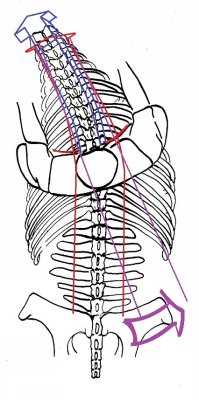 Describing his shoulder for, Gustave Steinbrecht emphasized the importance of keeping the croup straight. Pushing the shoulders slightly toward the inside of the ring stimulates lateral bending of the thoracic spine at the condition that the haunches don’t deviate toward the outside or the inside. The greatness of the shoulder for is to address the rotation, which in turn creates lateral bending of the thoracic spine. The amplitude of the transversal rotation is minimal and even a small displacement of the croup toward the outside enables the horse to avoid lateral bending of the thoracic spine.
Describing his shoulder for, Gustave Steinbrecht emphasized the importance of keeping the croup straight. Pushing the shoulders slightly toward the inside of the ring stimulates lateral bending of the thoracic spine at the condition that the haunches don’t deviate toward the outside or the inside. The greatness of the shoulder for is to address the rotation, which in turn creates lateral bending of the thoracic spine. The amplitude of the transversal rotation is minimal and even a small displacement of the croup toward the outside enables the horse to avoid lateral bending of the thoracic spine.
The rotation that is coupled with lateroflexion can be proper, shifting the dorsal spines toward the inside of the bend, or inverted, shifting the dorsal spines toward the outside of the bend. Executed, keeping the haunches perfectly straight, the shoulder for favors proper rotation. Instead, if the horse shifts the croup toward the inside, even just a few inches, the rotation of the thoracic vertebrae will likely be inverted.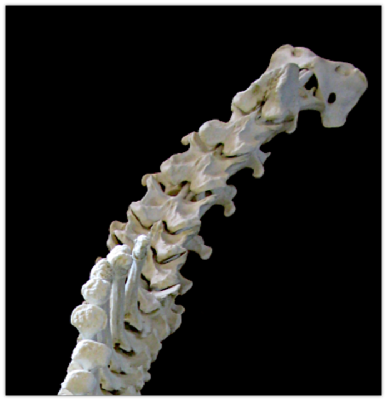
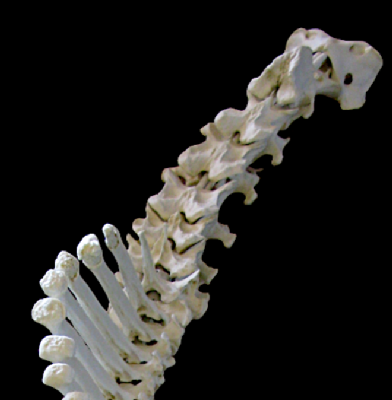 There is no question that lateral bending of the horse’s thoracic spine is created by the rider back, pelvis, and upper thighs, but the rider pelvis and upper thighs only suggest lateral bending. The horse processes the suggestion dealing with his muscle imbalance and other issues. Willingness can conflict with muscle imbalance, or memories, or central pattern generators. The horse is willing to please but protecting familiar patterns. If, for instance, the horse is used to travel with the haunches slightly shifted toward the right, the central pattern generators involved in locomotion have educated themselves to this habit, and the shift of the croup alters the horse ability to bend the thoracic spine to the left. Without straightening the hind legs, the rider will have great difficulties in bending the horse’s thoracic vertebrae. This detailed analysis belongs to the rider. One can focus on the bending of the thoracic spine and regard the slight displacement of the croup to the right as a detail that has nothing to do with the bending of the thoracic spine. Missing the detail, one will have great difficulty to bend the horse’s thoracic spine.
There is no question that lateral bending of the horse’s thoracic spine is created by the rider back, pelvis, and upper thighs, but the rider pelvis and upper thighs only suggest lateral bending. The horse processes the suggestion dealing with his muscle imbalance and other issues. Willingness can conflict with muscle imbalance, or memories, or central pattern generators. The horse is willing to please but protecting familiar patterns. If, for instance, the horse is used to travel with the haunches slightly shifted toward the right, the central pattern generators involved in locomotion have educated themselves to this habit, and the shift of the croup alters the horse ability to bend the thoracic spine to the left. Without straightening the hind legs, the rider will have great difficulties in bending the horse’s thoracic vertebrae. This detailed analysis belongs to the rider. One can focus on the bending of the thoracic spine and regard the slight displacement of the croup to the right as a detail that has nothing to do with the bending of the thoracic spine. Missing the detail, one will have great difficulty to bend the horse’s thoracic spine.
The video “The New Seat” talks about squeezing the lower thigh above the knees. The defect shifts the lower legs away from the horse’s sides and the rider’s ability to control the horse’s hind legs. The “detail” is often dismissed by the ones who have been taught or have developed the habit to ride this way. The detail does not affect the look, and many are convinced that they can do well and don’t have to work on the habit.
Heaven gates open to the one using their body instead of their hands. Equal precision and lightness are required at the level of the calves.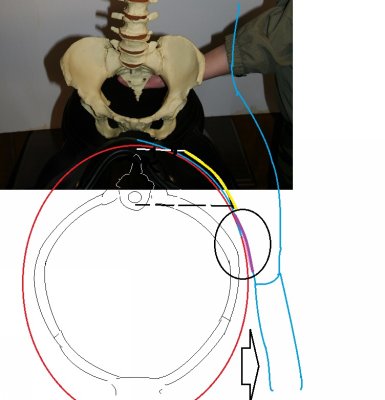 A horse cans feel under the rider’s calves, touches too subtle for a human to feel. Intermittent contacts associated with the calves held away from the horse’s sides create chaotic stimulus. The stirrups help in refining the touch of the calves, as long as the rider does not dig the heels down, but stability and precision originate from the rider in neutral balance over the seat bone and the study contact of the rider’s upper thighs. Equine body function is ruled by forces, energy, tensegrity storage, and reuse of elastic energy, force transport, close kinematics chain.
A horse cans feel under the rider’s calves, touches too subtle for a human to feel. Intermittent contacts associated with the calves held away from the horse’s sides create chaotic stimulus. The stirrups help in refining the touch of the calves, as long as the rider does not dig the heels down, but stability and precision originate from the rider in neutral balance over the seat bone and the study contact of the rider’s upper thighs. Equine body function is ruled by forces, energy, tensegrity storage, and reuse of elastic energy, force transport, close kinematics chain.
Stability, ontegrity, and clear conversation with the horse demands a seat allowing steady and light contact of the rider's upper thighs and muscles of the calf.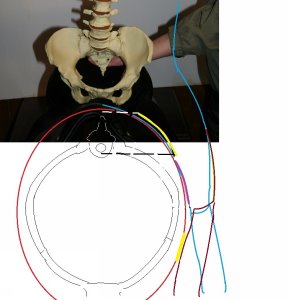
The equitation of gesture does not fit the actual horse. The details should not be regarded as separated body parts. The details are part of the integrity. The details are subtle, rapid, and changing constantly. They demand a rider physically as well as mentally tuned to the horse. Riding the details raise the equitation at a magical level of subtlety, precision, and efficiency,
Jean Luc


 twitter
twitter facebook
facebook pinterest
pinterest linkedin
linkedin